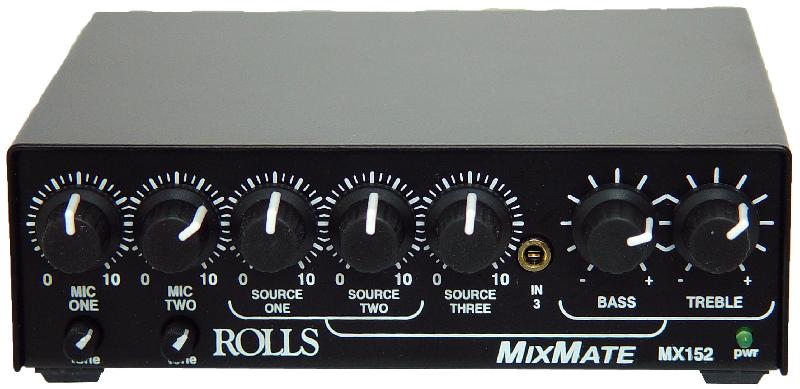MX152 Mix Mate
This product has been discontinued
- Description
- Specifications
The MX152 is a one-half rack space, two microphone and three stereo source mixer. The unit provides a compact and efficient way to mix sources such as AM/FM tuners, CD players, and video players with dynamic or condenser microphones. Applications include background music and paging for small clubs, churches, schools, restaurants, etc. Each microphone channel has a Level and Tone control. Sources One and Two have Level adjustments and pass through combined Bass and Treble controls. Source Three has a Level adjustment only. The Microphone inputs are balanced XLR jacks, all Source inputs are stereo RCA except for the front 1/8 jack on CH3 for an MP3 player, etc. The main output is stereo RCA. An included 12VAC adapter (Rolls PS12) provides power to the unit. A series of six DIP switches provide important features to the MX152. Two switches apply the 12VDC of phantom power to the individual Microphone Inputs. A second switch sums the program material of Source Three to mono, and a third sums the overall output to mono. Another switch provides priority ducking to Source Three input allowing that channel to mute the other source inputs for use with a jukebox. The final switch configures Microphone Input One as a paging input, ducking the other microphone and Sources One and Two.
- Input Impedance:
- Mic: 600 Ohms XLR balanced
- Source: 22K Ohms RCA
- Max Input Level:
- Mic: -14 dBV Mic level Max
- Source: 24 dBV
- Connectors: 2: XLR, 8: Stereo RCA
- Phantom Power: +12 VDC
- Max Gain:
- Mic: 60 dBV
- Source: 26 dBV
- Tone Controls: +/-12 dB 100 Hz Bass, +/-12 dB 11kHz Treble
- Noise Floor: - 80 dB
- S/N Ratio: 96 dB
- Priority Attenuation: 60 dB
- Power: 12VAC / 600 mA
- Size: 19" x 3.5" x 7.5"(48 x 9 x 19 cm)
- Weight: 2 lbs
- Two Microphone inputs with phantom power.
- Tone controls for each Mic input.
- Three stereo Source inputs
- Bass and Treble controls on Sources One and Two
- Priorit y ducking on Mic One and Source Three
- Switchable Mono/Stereo Unbalanced Output


